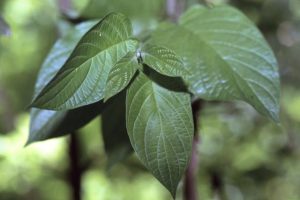A true California native beauty is the Pacific, or Mountain Dogwood (Cornus nuttallii). The dogwood display begins in the spring with exotic looking blooms, continues into late summer, with the development of startling cluster-fruits, then ends in autumn with a finale of branches filled with crimson leaves. Some of the best places to experience dogwoods are here in Tuolumne County along streams and ditch trails, as well as on the shadier sides of the mountains below 5000 ft.
Dogwoods are endemic to the western slopes of the Sierra Nevada and Cascade mountains from British Columbia to Southern California. They can also be found in coastal areas along the Pacific. They thrive in niches of the Sierra Nevada, as they prefer hot summers and cold winters, and grow well with moderate amounts of rainfall and snowmelt. They need partial shade because their thin bark must be protected from the sun. Dogwoods are often seen growing under the canopy of larger trees in our mixed coniferous forests or surrounded by an understory of native shrubs. A unique characteristic is that dogwoods can photosynthesize maximally in 1/3 of a portion of full sunlight; thus, shady forests do not hinder their ability to make food.
The eye-catching flowers begin to bloom sometime between April and June depending on elevation and conditions; sometimes there can be an additional flowering in the fall. The white showy petal-like structures are modified leaves called bracts. There are 4-8 bracts per bloom; each are 2-3”. The bracts surround a greenish-white center that contains 30-40 small true flowers. The flowers eventually develop into a type of fruit called a drupe by late summer. Each drupe is bright red to reddish-orange in color, about ½” in length and contains a cluster of 50-100 seeds.
The flowers are resplendent against the deep green background of the leaves once the tree sprouts new leaves in the spring. The leaves are 3-5” long and are elliptical in shape with a slight tooth to their edge. The veins curve out from the center rib to the edge of each leaf. At the ends of branches there are 2 pairs of opposite leaves giving a unique whorled appearance. The leaf petioles (the stalk attaching the leaf blade to the stem) droop, allowing the leaves to sit on and shade the tree’s branches from the sun. With autumn, the leaves steal the show with changes in color ranging from yellowish-pink to crimson red.
If you think that you would like to make a home for this native beauty in your garden, realize that new dogwood plants require extra care for a few years, but the extra effort is worth it. They require well-drained, preferably acidic soil that is high in inorganic material. Young trees should be planted among shrubs or under taller trees so that the vulnerable trunk is at least partially shaded. Protect young trees from deer that will browse the tender twigs.
Once dogwoods become established, they don’t need extra summer water or fertilizer. They also do not like to be pruned; the open wounds heal slowly. If you need to remove damaged branches, it is best to do so in late summer. Watch your dogwood trees for disease. The tender bark makes the tree vulnerable to attack by insects. They are susceptible to athracnose, a disease caused by the fungus Discula distructiva that causes leaves to spot or fall off.
Whether on a walk in the woods or peeking out your garden window, take some time during the coming spring to enjoy the splendor of the Pacific Dogwood. Watch its transforming beauty through the summer and autumn until it leaves fall once more for the coming winter.
Kathi Joye is a former University of California Cooperative Extension Master Gardener of Tuolumne County who lives among the dogwoods at 4,000 feet.
UCCE Master Gardeners of Tuolumne and Calaveras Counties can answer home gardening questions. Call 209-533-5912 or go to: http://ucanr.edu/survey/survey.cfm?surveynumber=7269 to fill out our easy-to-use problem questionnaire. Check out our website at: http://cecentralsierra.ucanr.edu/Master_Gardeners/ You can also find us on Facebook.



